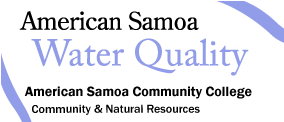 |
 |
|
| American Samoa Water Quality Projects |
| The American Samoa Interagency Piggery Management Council (ASIPMC) |
|
| Background of problems encountered in American Samoa |
 |
| The 1999 United States Department of Agriculture (USDA) Agricultural Census (USDA 1999) found that there are over 2,700 pig farms in American Samoa with a total swine population of over 35,000 head. Pig husbandry facilities in American Samoa typically contain 10 to 50 animals. A typical piggery consists of an open sided building on either a concrete or packed earth floor. Pig wastes are flushed from the floor with pressurized water. This waste slurry is often discharged directly to surface water or is contained in small, unlined cesspools. Although small-scale by some measures, the overall number and wide distribution of poorly managed piggeries are known to negatively impact human health and the environment (Fig 1, 2 & 3). |
| Pig manure like other animal wastes is high in nutrients including nitrogen and phosphorous. Pig manure also has a large biological oxygen demand (BOD) as well as being a source for human pathogens and parasites. These three components make pig manure a potential surface water, groundwater, and human health hazard if not properly managed. American Samoa pig farmers raise pigs almost entirely for cultural purposes. Because of the lack of an USDA-approved commercial slaughterhouse, the only means for legally selling pork is “on the hoof,” or as live animals to be used for cultural purposes. Ironically, the prices obtained for live weaner pigs are over two dollars a pound, regardless of health status or meat composition. This exceeds the commercial prices for imported pork, resulting in little incentive for pig farmers to move towards commercial production. As a result, there is also little incentive for good husbandry practices, as high prices for pigs can be obtained without having to meet any health standards and without having to use intensive inputs. |
| There exists little formal data on husbandry practices, although anecdotal experience suggests that most farmers do not provide adequately balanced diets or adequate water supplies for their pigs to achieve maximum growth. Furthermore, few farmers are addressing the parasite problem that plagues the territory. In 1998, a team of animal scientists from the University of Hawaii conducted a pig health survey throughout the American Pacific. American Samoa was found to have the highest rate of parasite infestation of any of the areas surveyed. The consequences of such poor husbandry are not only inefficient growth, but also economic, money spent on commercial feed is in essence wasted on parasite-infested pigs. Furthermore, these parasites pose a risk to human health, though their impacts are currently unknown due to lack of tracking by the Public Health. |
|
|
|


